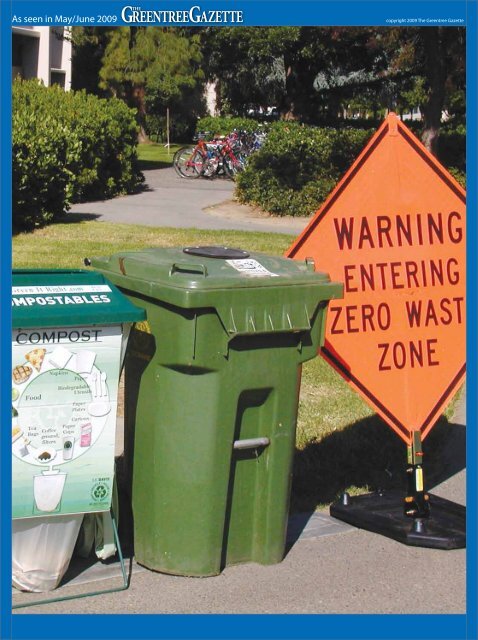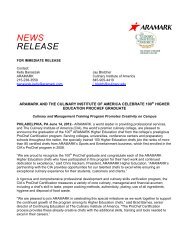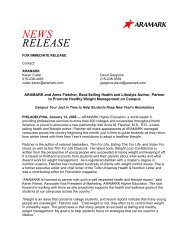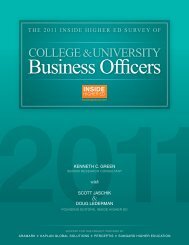GREENTREEGAZETTE - ARAMARK Higher Education
GREENTREEGAZETTE - ARAMARK Higher Education
GREENTREEGAZETTE - ARAMARK Higher Education
You also want an ePaper? Increase the reach of your titles
YUMPU automatically turns print PDFs into web optimized ePapers that Google loves.
As seen in May/June 2009<br />
the<br />
GreentreeGazette<br />
copyright 2009 The Greentree Gazette
As seen in May/June 2009<br />
the<br />
GreentreeGazette<br />
copyright 2009 The Greentree Gazette<br />
The<br />
food<br />
fight for<br />
zero<br />
waste<br />
b y T o m R o b i n s o n<br />
If you remember the iconic food fight at Faber College in the<br />
movie “Animal House,” you’ll appreciate how much different campus<br />
dining services are today. The oh-so-gross Blutarski (played by John<br />
Belushi) has been replaced by the oh-so-green student sustainability<br />
coordinator. And most everything in the dining hall has changed as well.<br />
It’s a serious attempt to produce zero student kvetching as well as zero<br />
waste. Zero kvetching is self-explanatory if you know some Yiddish. Zero waste<br />
means all dining materials are recycled back into nature or the marketplace in a<br />
manner that protects human health and the environment.<br />
On many campuses, what you eat, where it comes from, where the uneaten<br />
leftovers and kitchen waste go, and even the business model have become a<br />
sophisticated enterprise. The new breed of University Dining Services (UDSs)<br />
is a closed-loop system that would make any tree-hugger or thrifty CFO happy.<br />
For colleges and universities that contract with a service to manage their<br />
dining services, <strong>ARAMARK</strong> and Sodexo are the two largest in the U.S. The<br />
U. K.’s Compass Group operates in the U.S. as well, under several brand names<br />
including Bon Appetit and Chartwells.<br />
www.greentreegazette.com Business Intelligence for 21st Century <strong>Higher</strong> <strong>Education</strong> • the greentree gazette 5
As seen in May/June 2009<br />
the<br />
GreentreeGazette<br />
copyright 2009 The Greentree Gazette<br />
apples, organic granola, ice cream, and<br />
several varieties of cheeses from local<br />
purveyors.<br />
• Served fair trade coffee in all dining<br />
halls from Dean’s Beans in Orange,<br />
Massachusetts.<br />
More and more students are eschewing<br />
burgers and fries for more fruits and vegetables, organics and<br />
locally produced foods.<br />
Food in<br />
Many students are really and truly<br />
seeking out healthier alternatives to<br />
burgers and pizza. They are eating<br />
more fresh produce, more fruits and<br />
vegetables and leaner cuts of meat with<br />
less sauces. They are avoiding hormones<br />
and antibiotics.<br />
The student preference for more<br />
fresh and organic offerings is often<br />
accomplished by buying from local<br />
producers. Williams College, for instance:<br />
• Spent 20 cents per meal to increase<br />
consumption of local and organic<br />
food by 30%.<br />
Locally sourced produce at the University of Florida dining services.<br />
• Hired a student summer intern to<br />
research and connect with sustainable<br />
food producers in the Berkshires.<br />
• Replaced all conventional milk with<br />
milk from the grass-fed, hormonefree<br />
cows of Highlawn Farm in Lee,<br />
Massachusetts.<br />
• Offered local, grass-fed beef<br />
hamburgers nightly at Dodd House<br />
and Mission Park.<br />
• Purchased most summer vegetables<br />
and much of its winter storage<br />
vegetables from a 60-acre family farm<br />
located 10 minutes from the college.<br />
• Purchased organic shiitake<br />
mushrooms, organic honey, low-spray<br />
Tray-less<br />
More than 250 <strong>ARAMARK</strong> campus<br />
partners have removed trays from their<br />
residential dining locations to reduce<br />
food waste and conserve water and<br />
energy. <strong>ARAMARK</strong> experienced a food<br />
waste reduction of 25 to 30 percent<br />
per person after trays were removed.<br />
Armed with a plate instead of a tray,<br />
people don’t—can’t—pile on as much<br />
grub. Meanwhile, the water and energy<br />
required to wash trays is eliminated.<br />
Biodegradable packaging<br />
While plastic knives and forks are<br />
convenient and Styrofoam plates and<br />
cups keep food at the correct temperature,<br />
they cause ecological nightmares.<br />
The University of Minnesota has<br />
con verted 35 percent of packaging to<br />
biodegradable (for example, cornstarch or<br />
cellulose) in campus dining locations. A 24oz<br />
fountain cup made of corn resin or starch<br />
breaks down nicely in compost piles within<br />
45 days. Minnesota’s Green Team (student<br />
sustainability interns) help customers<br />
compost their food waste and biodegradable<br />
packaging in dining locations.<br />
Vending<br />
As chips and candy bars give way to fresh<br />
fruit and low-fat alternatives, the vending<br />
machines are also becoming more ecofriendly.<br />
Smart metering and controls<br />
turn off lights during slow periods. LED<br />
lighting reduces energy consumption.<br />
PepsiCo now has vending machines<br />
that emit 12 percent less greenhouse<br />
gas and use carbon dioxide, a<br />
natural refrigerant, instead of hydrofluorocarbons.<br />
The comp any is also<br />
eliminating HFCs from the insulating<br />
foam in vending machines, coolers and<br />
fountain equipment.<br />
Food out<br />
In an ideal closed-loop system, food is<br />
delivered, prepared, served and completely<br />
eaten. That is “food in.” However, not every<br />
pound finds its way into tummies. How do<br />
college dining services deal with the waste?<br />
That is “food out.”<br />
6 the greentree gazette • Business Intelligence for 21st Century <strong>Higher</strong> <strong>Education</strong> www.greentreegazette.com
As seen in May/June 2009<br />
the<br />
GreentreeGazette<br />
copyright 2009 The Greentree Gazette<br />
The University of South Carolina has created a network of regional suppliers.<br />
U C Davis has introduced utensils that biodegrade<br />
in landfills in 45 days.<br />
According to the U.S. Environmental<br />
Protection Agency, food waste is the<br />
least recycled material in the United<br />
States. Studies by the U.S. Department of<br />
Agriculture have shown that every year,<br />
Americans throw away 96 billion pounds of<br />
food—3,044 pounds of food per second!<br />
Campus dining services have become<br />
very aggressive and quite efficient in<br />
reducing waste.<br />
Berea College Farm composts waste for fertilizer, recycles<br />
manure from its own livestock and produces USDA Certified<br />
Organic vegetables, culinary herbs, tree fruits, berries, mushrooms,<br />
and grains.<br />
Composting and decomposition<br />
Organic waste has intrinsic value and can<br />
be reused in numerous ways.<br />
The University of Vermont and<br />
the Intervale Compost Project work<br />
together to reduce the waste that<br />
enters landfills. Their methods employ<br />
traditional composting. Pre- and postconsumer<br />
food scraps are collected from<br />
several campus dining locations each<br />
day, then transported for composting to<br />
the Invervale facility, less than a<br />
mile from campus. Food waste<br />
is layered with other organic<br />
waste. The resulting compost<br />
is then sold to garden centers,<br />
farms, nurseries and landscapers.<br />
Completing the circle, UVM’s<br />
dining services buys produce<br />
grown using this same compost.<br />
Instead of heading for the<br />
landfill, the kitchen scraps from<br />
The College of Southern Idaho’s<br />
dining hall now become worm<br />
food or valuable compost, thanks<br />
to a new partnership between<br />
the CSI Agriculture Department’s horticulture<br />
program and CSI Dining Services,<br />
operated by <strong>ARAMARK</strong>. Many schools<br />
compost on campus and use the nutrients<br />
to fertilize college farms, student gardens<br />
or campus landscaping.<br />
A firm named BioHitech America<br />
manu factures organic waste decomposition<br />
systems in which refined microorgan<br />
isms transform organic waste into<br />
a liquid that can be safely sent down the<br />
drain as treatable wastewater. Within<br />
24 hours the decomposition system<br />
8 the greentree gazette • Business Intelligence for 21st Century <strong>Higher</strong> <strong>Education</strong> www.greentreegazette.com
As seen in May/June 2009<br />
the<br />
GreentreeGazette<br />
copyright 2009 The Greentree Gazette<br />
UF’s award-winning program has recovered and recycled<br />
over 200 million pounds of materials since 1989.<br />
will liquify meat, poultry, fish, fruit,<br />
vegetables, rice, pasta, bread, noodles,<br />
grains, coffee, egg shells and dairy<br />
products. There’s nothing to haul away,<br />
so no vehicle fuel burned.<br />
Minnesota’s student Green Team volunteers to help educate other students about recycling and composting.<br />
Operating a BioHitech machine at full<br />
capacity for 1 year:<br />
• Reduces greenhouse gases equivalent<br />
to taking 40 cars off the road<br />
• Saves 1,200 gallons of diesel fuel<br />
• Reduces carbon dioxide by 470,000<br />
pounds—equivalent to about 100<br />
trees<br />
• Returns tens of thousands of gallons<br />
of water a year to the ecosystem<br />
Used fryer oil has advanced from<br />
the greasy bane of fast food kitchens<br />
to the darling of biofuel production.<br />
Many campuses run their bus fleets on a<br />
blend of 10 percent recycled oil and 90<br />
percent diesel. Some more sophisticated<br />
engines run on 100 percent true biofuel<br />
from non-petroleum sources. Fryer oil is<br />
now so valuable a commodity that “oil<br />
pirates” have been known to steal what<br />
once couldn’t be given away.<br />
Biodegradable packaging<br />
To reduce non-food waste, students<br />
at colleges like Baylor University, the<br />
University of North Carolina Chapel<br />
Hill, Salem College and University of<br />
Florida are piloting reusable plastic “togo”<br />
containers in their dining halls. They<br />
can be sanitized at temperatures reaching<br />
180 degrees and reused, cutting down<br />
Western Illinois University students ratchet up campus RecycleMania efforts with grassroots marketing<br />
and student-produced PSAs.<br />
overall container consumption.<br />
In the dining halls at the University<br />
of Minnesota, Twin Cities about 35<br />
percent of the packaging in use is now<br />
biodegradable. Packaging such as the<br />
24oz fountain cup, salad bowls and<br />
plates are made of corn resin or starch<br />
and take approximately 45 days to break<br />
down in compost piles.<br />
Good eats. Good business.<br />
Good deeds.<br />
Recycling and decomposing saves money<br />
as it helps save the environment. The costs<br />
of collecting and hauling as well as landfill<br />
dumping fees are expensive. Reworking<br />
organic waste on campus eliminates many<br />
such expenses. Some schools even produce<br />
revenue from selling waste to third parties.<br />
There are social benefits as well. The<br />
“buy local” movement has spawned<br />
Community Supported Agriculture<br />
whereby local farmers and processors sell<br />
to local restaurants and institutions. The<br />
local economy benefits, while carbon<br />
emissions and costs associated with<br />
transport are greatly reduced.<br />
Perfection—easier said than done<br />
In her sustainability zeal, Amanda<br />
www.greentreegazette.com Business Intelligence for 21st Century <strong>Higher</strong> <strong>Education</strong> • the greentree gazette 9
As seen in May/June 2009<br />
the<br />
GreentreeGazette<br />
copyright 2009 The Greentree Gazette<br />
Ambramson, a student at Keene State<br />
College, took on the college’s dining service<br />
contractor Sodexo for not doing enough<br />
local sourcing and for importing Mexican<br />
out-of-season vegetables. How ever, she discovered<br />
that nothing is simple. “Students,<br />
even good-hearted ones, want tomatoes<br />
in January,” she says. The UDS contractor<br />
must cater to the tastes of all students to<br />
assure a contract renewal.<br />
At larger institutions coordinating<br />
dozens of small farmers may not be<br />
possible. When crossing state lines,<br />
animal proteins (meat, poultry, eggs,<br />
etc.) from small producers must be<br />
inspected by a USDA facility or onsite.<br />
For many small producers, that’s<br />
impractical and expensive. Dining<br />
service contractors want small farmers to<br />
deal with the existing wholesale, storage<br />
and transportation system.<br />
It is a reality that lamb imported from<br />
Australia on a massive scale can be less<br />
expensive and more efficient than local<br />
sources, despite the many ‘food miles.’<br />
Amanda now says she wants to work for<br />
a dining contractor upon graduation to<br />
negotiate the balance between sustainability<br />
and marketability.<br />
While the payout for composting and<br />
Food scraps are mixed with water in this decomposter, manufactured by BioHitech, and converted to a<br />
harmless effluent that is returned to the ecosystem.<br />
decomposition is attractive, not every<br />
capital budget can handle the upfront costs.<br />
“Working with the latest Campus<br />
Carbon Calculator, we and our campus<br />
partners will all better understand the<br />
environmental impact of our food<br />
choices, and make both personal and<br />
environmentally responsible decisions<br />
about the foods we choose,” says Chris<br />
Stemen, senior director of sustainability<br />
at <strong>ARAMARK</strong> <strong>Higher</strong> <strong>Education</strong>.<br />
By 2010, <strong>ARAMARK</strong> plans to<br />
implement energy and water conservation<br />
measures at every partner campus. It will<br />
only purchase paper products made with<br />
recycled content; utilize green cleaning<br />
products at all locations; divert 100<br />
percent of fryer oil waste; and increase<br />
the level of sustainable food offerings<br />
Favorite dining hall foods in 2009<br />
1. Locally-grown fruits and veggies<br />
2. Crispy garlic-ginger chicken wings<br />
3. Mac ’n five cheeses<br />
4. Vietnamese Pho<br />
5. Green tea and pomegranate smoothies<br />
6. Crab cake sliders<br />
7. Mini samosas<br />
8. Tilapia Veracruz<br />
9. Goat cheese salad<br />
10. Chicken Molé<br />
served by at least five percent per year.<br />
Arlin Wasserman, vice president<br />
of corporate citizenship at Sodexo,<br />
offers that the ultimate solution is not<br />
“tinkering with marginal benefits of<br />
handling organic wastes in the current<br />
food system, but reinventing the process<br />
to eliminate them.” Don’t produce so<br />
much waste. Donate unserved food to<br />
food banks. Plan menus that eliminate<br />
unused ingredients. Wasserman goes on<br />
to say, “Even products made from ecofriendly<br />
materials like cornstarch and<br />
bamboo are not as good as washables<br />
and reusable containers.”<br />
Zero waste and 100 percent student<br />
happiness may be unattainable goals, but<br />
on a growing number of campuses they are<br />
worth the fight. n<br />
Student tastebuds over two decades<br />
Sodexo provides food services to more than 800 colleges in the U.S. and Canada,<br />
and they’ve just released some taste preference data from student dining halls.<br />
Favorite dining hall foods in 1989<br />
1. Fruit and cottage cheese plate<br />
2. Chicken nuggets<br />
3. Turkey Tetrazini<br />
4. Chicken Chop Suey<br />
5. Egg, bacon and cheese English muffin<br />
6. Half sandwich and cup of soup<br />
7. Taco bar<br />
8. Spanish beef and rice<br />
9. Vegetarian bean chili<br />
10. Algerian lamb stew<br />
10 the greentree gazette • Business Intelligence for 21st Century <strong>Higher</strong> <strong>Education</strong> www.greentreegazette.com





